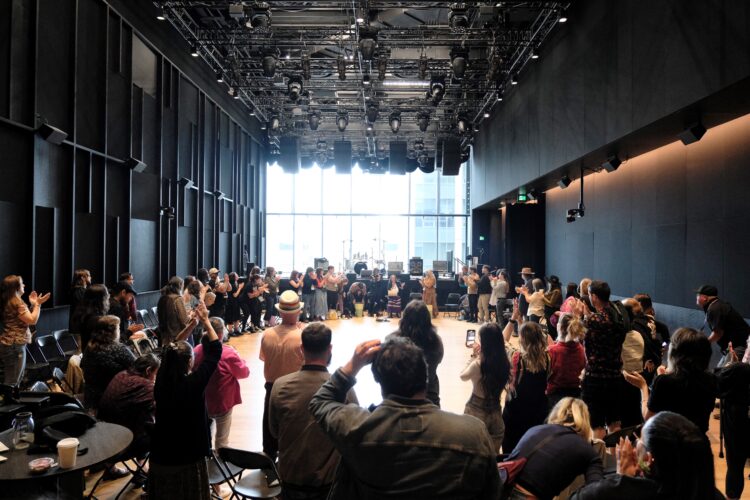At the head of the sharing circle at TD Music Hall, with the rear-stage curtains open to the outside world, sage burning in the middle of the room, and flanked by elders Louise Lahache and Gerard Sagassige, Elaine Bomberry delivered the keynote address to officially start the conference part of the 2024 International Indigenous Music Summit.
A kind of founding Auntie of the music industry, Bomberry – of Anishnaabe and Cayuga heritage – has worked as a freelance Indigenous performing arts activist, promoter, manager, and TV and radio producer for almost 35 years. In that time, she’s been one of the driving forces for many of the significant achievements for Indigenous people in the Canadian music industry. At the keynote, she traced some of her career highlights and shared her perspective.
Living and working in Oshweken, on the Six Nations of the Grand River in Southern Ontario, Bomberry talked about starting out in the ‘90s, “when Indigenous self-determination was starting to happen in the arts,” she said. When Indigenous actor (and fellow Six Nations resident) Gary Farmer wanted to start a radio station in Six Nations, he recruited Bomberry for a show, and later for the volunteer Board of Directors. “CKRZ, Rez Radio, didn’t fit the CRTC guidelines, so we were pirates for a year,” she said, but the organization approved the station after that. It’s now been on the air for 34 years.
 In 1996, Bomberry was chosen as the production manager for a Making a Noise: A Native American Musical Journey with Robbie Robertson, about The Band founder’s return visit to Six Nations, where he spent his childhood summers. She played an excerpt from a recorded interview with Robertson that she conducted on her radio show, and played an unreleased song that he shared on her program.
In 1996, Bomberry was chosen as the production manager for a Making a Noise: A Native American Musical Journey with Robbie Robertson, about The Band founder’s return visit to Six Nations, where he spent his childhood summers. She played an excerpt from a recorded interview with Robertson that she conducted on her radio show, and played an unreleased song that he shared on her program.
Bomberry played a role in the establishment of the ELMNT FM Indigenous radio stations in Toronto and Ottawa. She also discussed how she – along with David McLeod, General Manager of Native Communications Incorporated (NCI) – was part of a committee that developed the Aboriginal Award category for the JUNO Awards in the ‘90s. And how “it took 25 years to finally separate it into both traditional and contemporary categories.”
The veteran multi-tasker is especially passionate about the Rez Blues movement. “Six Nations is a hotbed of Indigenous blues,” she said, and told the story of the first Rez Blues performance in Toronto, where the promoter insisted on a venue with a capacity of only 200; after more than 300 people showed up, the following year they played to a crowd of 1,200. Bomberry has produced 13 one-hour Rez Blues shows for APTN (the Aboriginal Peoples Television Network), and wants to make a documentary film. In a workshop that she presents at festivals and conferences, she talks (as she did here) about the links between African and Indigenous roots of the blues: how runaway slaves went to reservations for sanctuary; how the 4/4 drumbeat of blues is the powwow heartbeat; how underground railroad routes follow old Indian trails; how bluesmen Little Walter, Big Joe Williams, and Charley Patton were all of Indigenous heritage.
Among her many accomplishments, Bomberry set up her own talent agency, All Nations Talent Group. She started the 2 Rivers Remix Society, a B.C.-based non-profit group that produces a free “movable feast” of contemporary Indigenous music and culture, bringing music festival shows to small Indigenous communities that wouldn’t otherwise see them, including such artists as Logan Staats, Laura Niquay, Aysanabee, Leela Gilday, and Snotty Nose Rez Kids. And she’s now a lyricist: “I became a member of SOCAN,” she said, and played a recorded song (co-written with, and performed by, her husband, Mohawk singer-songwriter Murray Porter) for which she wrote the lyrics.
Her advice to the assembled delegates was, “We’re not in competition with each other, we complement each other. We’re all moving in the same direction, so let’s take care of each other. Let’s do it with love and grace. Our voices are one.”